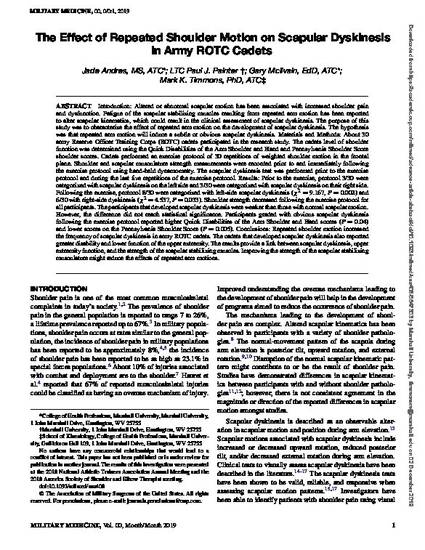
Article
The Effect of Repeated Shoulder Motion on Scapular Dyskinesis in Army ROTC Cadets
Military Medicine
(2020)
Abstract
Introduction: Altered or abnormal scapular motion has been associated with increased shoulder pain
and dysfunction. Fatigue of the scapular stabilizing muscles resulting from repeated arm motion has been reported to alter scapular kinematics, which could result in the clinical assessment of scapular dyskinesis. The purpose of this study was to characterize the effect of repeated arm motion on the development of scapular dyskinesis. The hypothesis was that repeated arm motion will induce a subtle or obvious scapular dyskinesis.
Materials and Methods: About 30 Army Reserve Officer Training Corps (ROTC) cadets participated in the research study. The cadets level of shoulder function was determined using the Quick Disabilities of the Arm Shoulder and Hand and Pennsylvania Shoulder Score shoulder scores. Cadets performed an exercise protocol of 30 repetitions of weighted shoulder motion in the frontal plane. Shoulder and scapular musculature strength measurements were recorded prior to and immediately following the exercise protocol using hand-held dynamometry. The scapular dyskinesis test was performed prior to the exercise protocol and during the last five repetitions of the exercise protocol.
Results: Prior to the exercise, protocol 3/30 were categorized with scapular dyskinesis on the left side and 3/30 were categorized with scapular dyskinesis on their right side. Following the exercise, protocol 8/30 were categorized with left-side scapular dyskinesis (χ2 = 9.167, P = 0.002) and 6/30 with right-side dyskinesis (χ2 = 4.537, P = 0.033). Shoulder strength decreased following the exercise protocol for all participants. The participants that developed scapular dyskinesis were weaker than those with normal scapular motion.
However, the difference did not reach statistical significance. Participants graded with obvious scapular dyskinesis
following the exercise protocol reported higher Quick Disabilities of the Arm Shoulder and Hand scores (P = 0.04)
and lower scores on the Pennsylvania Shoulder Score (P = 0.005).
Conclusions: Repeated shoulder motion increased the frequency of scapular dyskinesis in army ROTC cadets. The cadets that developed scapular dyskinesis also reported greater disability and lower function of the upper extremity. The results provide a link between scapular dyskinesis, upper extremity function, and the strength of the scapular stabilizing muscles. Improving the strength of the scapular stabilizing musculature might reduce the effects of repeated arm motions.
Keywords
- Military Medicine,
- Shoulder,
- Scapular Dyskinises
Disciplines
Publication Date
June, 2020
DOI
10.1093/milmed/usz408
Citation Information
Jade A Andres, Pual J Painter, Gary E McIlvain and Mark K Timmons. "The Effect of Repeated Shoulder Motion on Scapular Dyskinesis in Army ROTC Cadets" Military Medicine Iss. 5-6 (2020) p. e811 - e817 Available at: http://works.bepress.com/mark-timmons/3/
